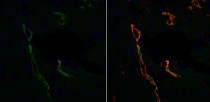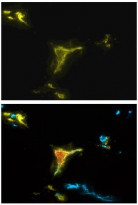ARG66602
anti-LYVE1 antibody
anti-LYVE1 antibody for Flow cytometry,ICC/IF,IHC-Frozen sections,IHC-Formalin-fixed paraffin-embedded sections and Mouse,Rat
Overview
| Product Description | Rabbit Polyclonal antibody recognizes LYVE1 |
|---|---|
| Tested Reactivity | Ms, Rat |
| Tested Application | FACS, ICC/IF, IHC-Fr, IHC-P |
| Host | Rabbit |
| Clonality | Polyclonal |
| Isotype | IgG |
| Target Name | LYVE1 |
| Antigen Species | Mouse |
| Immunogen | Recombinant Mouse soluble LYVE1. |
| Conjugation | Un-conjugated |
| Alternate Names | Lymphatic vessel endothelial hyaluronic acid receptor 1; Hyaluronic acid receptor; LYVE-1; XLKD1; HAR; Extracellular link domain-containing protein 1; CRSBP-1; Cell surface retention sequence-binding protein 1 |
Application Instructions
| Application Suggestion |
|
||||||||||
|---|---|---|---|---|---|---|---|---|---|---|---|
| Application Note | * The dilutions indicate recommended starting dilutions and the optimal dilutions or concentrations should be determined by the scientist. |
Properties
| Form | Liquid |
|---|---|
| Buffer | PBS |
| Storage Instruction | For continuous use, store undiluted antibody at 2-8°C for up to a week. For long-term storage, aliquot and store at -20°C or below. Storage in frost free freezers is not recommended. Avoid repeated freeze/thaw cycles. Suggest spin the vial prior to opening. The antibody solution should be gently mixed before use. |
| Note | For laboratory research only, not for drug, diagnostic or other use. |
Bioinformation
| Database Links |
Swiss-port # Q8BHC0 Mouse Lymphatic vessel endothelial hyaluronic acid receptor 1 |
|---|---|
| Gene Symbol | LYVE1 |
| Gene Full Name | lymphatic vessel endothelial hyaluronan receptor 1 |
| Background | This gene encodes a type I integral membrane glycoprotein. The encoded protein acts as a receptor and binds to both soluble and immobilized hyaluronan. This protein may function in lymphatic hyaluronan transport and have a role in tumor metastasis. [provided by RefSeq, Jul 2008] |
| Function | Ligand-specific transporter trafficking between intracellular organelles (TGN) and the plasma membrane. Plays a role in autocrine regulation of cell growth mediated by growth regulators containing cell surface retention sequence binding (CRS). May act as a hyaluronan (HA) transporter, either mediating its uptake for catabolism within lymphatic endothelial cells themselves, or its transport into the lumen of afferent lymphatic vessels for subsequent re-uptake and degradation in lymph nodes. [UniProt] |
| Cellular Localization | Membrane; Single-pass type I membrane protein. Note=Localized to the plasma membrane and in vesicles near extranuclear membranes which may represent trans-Golgi network (TGN) and endosomes/prelysosomeal compartments. Undergoes ligand-dependent internalization and recycling at the cell surface. [UniProt] |
| Calculated MW | 35 kDa |
| PTM | O-glycosylated. [UniProt] |
Images (4) Click the Picture to Zoom In
-
ARG66602 anti-LYVE1 antibody IHC-Fr image
Immunohistochemistry: Cryo sections of Mouse colon carcinoma tissue stained with ARG66602 anti-LYVE1 antibody (red) and anti-Human CD31 (green). CD31; LYVE1; Merged (left to right).
-
ARG66602 anti-LYVE1 antibody IHC-P image
Immunohistochemistry: Paraffin-embedded Mouse intestine tissue stained with ARG66602 anti-LYVE1 antibody.
-
ARG66602 anti-LYVE1 antibody IHC image
Immunohistochemistry: Rat cardiac lymphatic microvessels, stained with anti-Rat Podoplanin at 1:400 dilution (left panel) and ARG66602 anti-LYVE1 antibody at 1:1000 dilution (right panel).
-
ARG66602 anti-LYVE1 antibody IHC-Fr image
Immunohistochemistry: Frozen section of Mouse prostate stained with ARG66602 anti-LYVE1 antibody.









